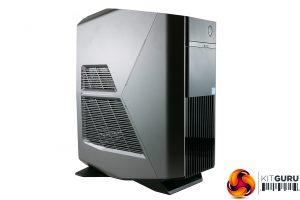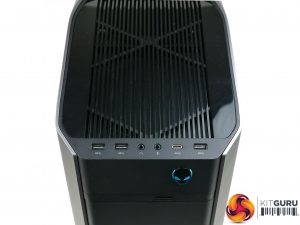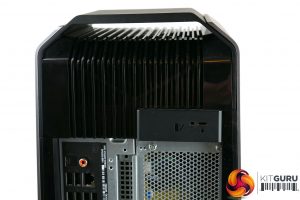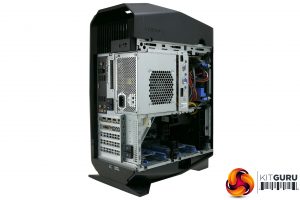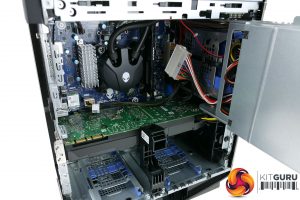The Aurora R7 can’t hold a candle to the tiny stature of the recently reviewed Corsair One Elite, but compared to most other PCs it’s an impressively small machine. With a footprint of just 361mm x 212mm and a height of 473mm it’s comfortably smaller than many micro-ATX chassis.
It’s also a tidy looking machine, despite its lack of either premium materials such as aluminium and glass, or a side window. Instead Alienware has opted for a plastic exterior with a mixture of finishes and the addition of external lights to jazz things up.
It works, too. The angular shape adds a bit of interest while the silver sides and black fins running down the middle contrast nicely with each other. The former is a painted finish while the latter is a mix of matt and glossy black plastic.
Key to the final look is the addition of the lighting zones. There’s the signature Alienware logo on the front and a trio of light strips on either side panel. The colour and brightness of the logo and each panel can be controlled independently too, using Alienware’s AlienFX software.
Alienware isn’t known for making PCs that are easy to get inside and upgrade, but this machine makes access fairly easy, despite its compact size.
Remove one screw from the rear panel then pull back the plastic tab and the side panel falls open revealing the innards. Cleverly, the side panel doesn’t even leave a trail of cables for the lighting. Instead it uses a system of sprung gold contacts to connect the panel up.
Once opened, at first it seems like there's very little in the way of accessible components other than the single 3.5inch drive bay. However, slide up another couple of plastic levers and you can fold out the silver section that's mounted the PSU. This then provides access to the motherboard, graphics card, CPU and a couple of 2.5inch drive bays.
Not that upgrades are going to be entirely straightforward. Most of the components seem to be of a standard form factor – micro-ATX motherboard, standard graphics card, etc – but there are some custom retaining clips and other parts that may limit how much you can change.
As such, if you’re buying the top of the line machine, it’s likely there are going to be relatively few upgrades that you’ll want to make yourself – swapping out motherboards and the like isn't something we'd want to try.
However, if you opt for something like the £949 system that includes an Intel Core i5-8400 and Nvidia GTX 1060, it should be simple enough to upgrade the graphics card, storage and RAM at a later date. Just be sure to opt for the 850W case/PSU if you're ever thinking of upgrading to a GTX 1080 Ti, as you'll need the extra power cables.
As for the overall cooling setup, this does depend on the configuration, with some using all air and some using liquid coolers. Here we’ve got a custom Alienware liquid cooler for the CPU that draws heat up to a 120mm radiator and fan at the top of the case.
The graphics card and PSU rely on their own fans while the rest of the system is cooled by a single 120mm fan in the front of the case. There’s no extra space to add any further cooling.
 KitGuru KitGuru.net – Tech News | Hardware News | Hardware Reviews | IOS | Mobile | Gaming | Graphics Cards
KitGuru KitGuru.net – Tech News | Hardware News | Hardware Reviews | IOS | Mobile | Gaming | Graphics Cards


